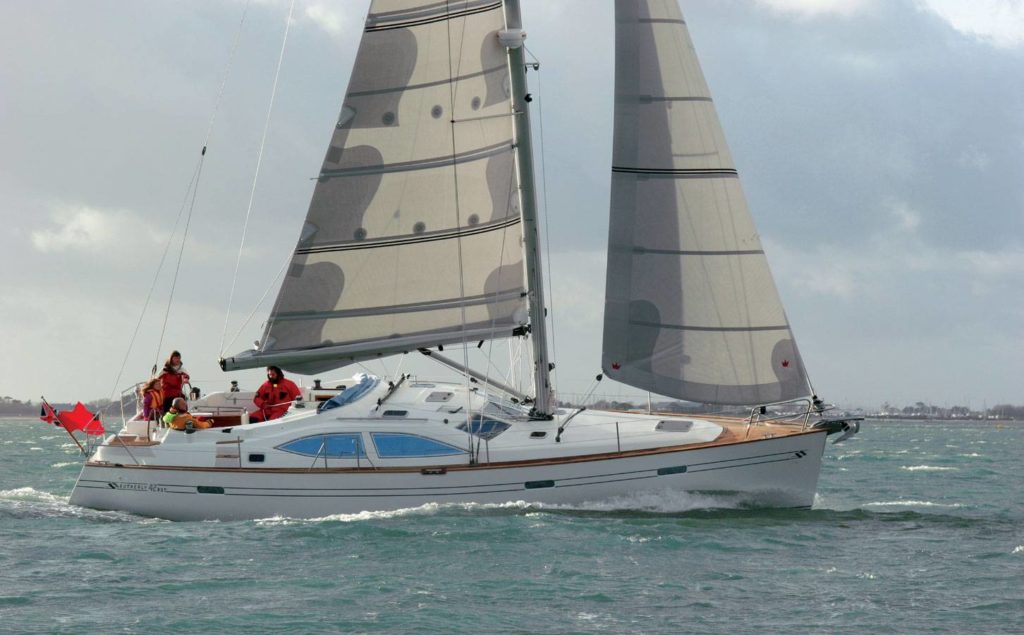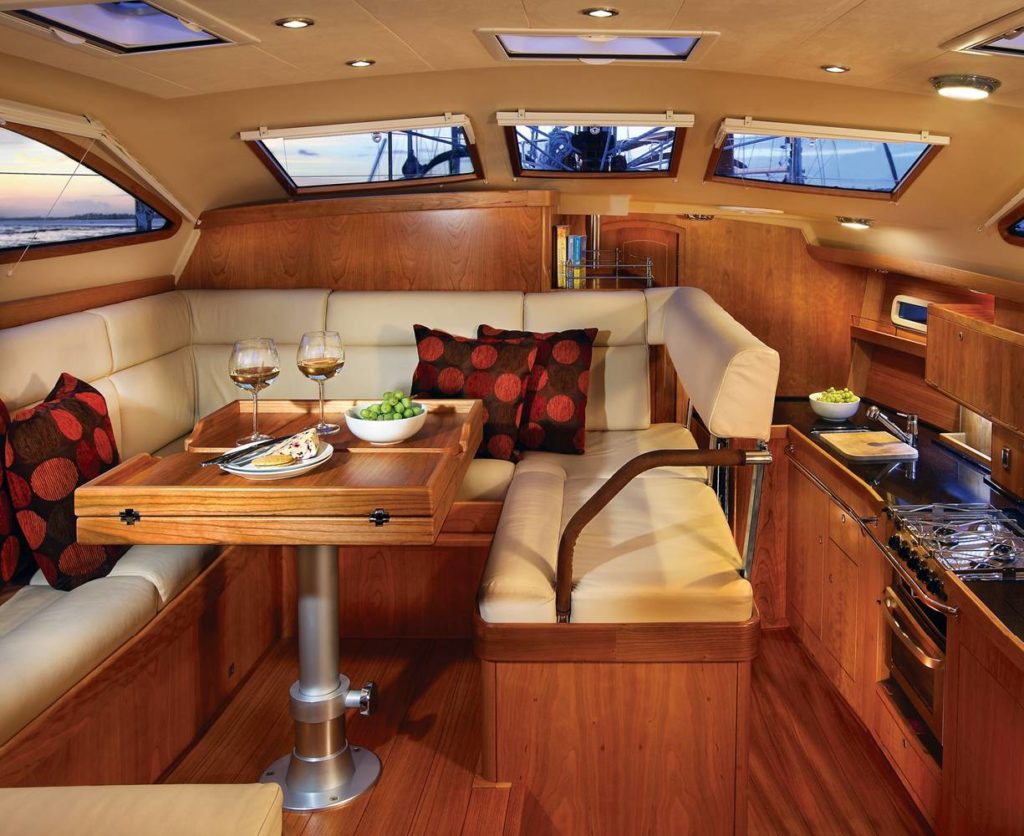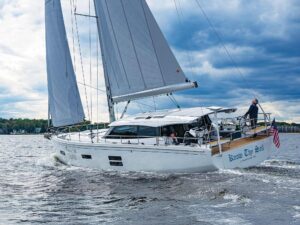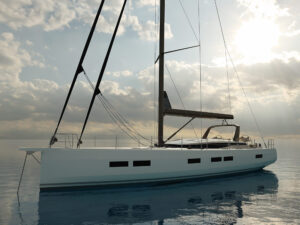
Word of a new 42-foot deck-saloon design isn’t breaking news among cruising sailors, but having inspected and sailed the British-built Southerly 42RST (raised saloon, twin wheel), I promise you, this one is different.
Based on my experience, the 42RST sails to windward well, handles easily, could go offshore capably, and can sail or even park in the shallowest of waters quite nicely. As with all models in Northshore Yachts’ Southerly line, the distinguishing trait of this design is its cast-iron lifting keel, which presents an efficient shape when lowered for closehauled sailing and retracts flush with an iron grounding plate when raised. As I learned, you can stick the tip of the keel in the mud when the depth sounder reads 2.3 meters (7 feet 6 inches), then engage the hydraulic lifting cylinder and quickly come free. I could also raise the keel completely in 50 seconds (it went down in 40), and if we’d had the time and inclination, we could’ve floated into less than 3 feet of water and let the hull sit comfortably on the bottom as the tide went out.
Rob Humphreys designed the 42RST hull with extremely broad stern sections, a skeg protecting the propeller amidships, and two short, semibalanced rudders angled outboard, all of which allow the boat to operate safely in water that’s shallow and sometimes disappears altogether. I was surprised and pleased to find that this arrangement meant that when heeling as we sailed upwind in puffs over 20 knots, the windward rudder came clear of the water and the leeward rudder, now vertical, did its job efficiently. The steering didn’t have a lot of feel to it, perhaps due to the extra linkages, but even in the strongest puffs and when heeled well over, I always had good steering control.
Notably, with the keel down, I was able to spin the boat in a circle that measured less than one and a half boat lengths in diameter. When I tried this with the keel up, I couldn’t tack without falling into irons.
Thanks to the narrow sheeting angles made possible by the self-tacking jib, the 42RST made excellent time upwind. We’d put two reefs in the main and were sailing in flat water at 6.3 to 6.7 knots, tacking through 85 degrees. For a cruising boat, I found this extraordinary; clearly, Humphreys’ experience as a raceboat designer of similarly wide-transom, twin-rudder, open-class boats has had an impact here.
The 42RST, which is a makeover of the earlier 42RS, has a new deck mold designed by Stephen Jones that splits the helm stations and opens up the cockpit. When I went sailing in the harbor at Chichester, England, on a breezy spring day, I found it easy to brace myself in the cockpit. The table is a molded fiberglass unit with a grabrail that means business.
In a narrow part of the harbor, Northshore’s Robert Hughes demonstrated one other unique benefit of having twin rudders and a centerline prop: The 42RST steers remarkably well in reverse. If backing up is a maneuver that occasionally causes you embarrassment, this craft just might rid you of that concern.

Innovation by necessity explains the unusual features of the 42RST’s interior. Because of the notably central position of the lifting keel and apparatus, sailors won’t mistake the main saloon for their living room. The nav desk, to starboard, and the settees and dining area, to port, are more elevated than is normal for a deck saloon-style cruiser, with water and fuel tanks located centrally, beneath the raised cabin sole. Access through the companionway is quick, with only one step down, and from either settees or nav station, you’ll find pleasing, 270-degree outboard views.
Moving forward to the in-line galley, on the starboard side, means taking a couple of more steps down. Plenty of natural light reaches the galley through the large saloon windows and a portlight in the hull, but for those who don’t like steps and want a wide-open space incorporating the saloon and galley, this won’t be an ideal setup. Yet each space on its own struck me as comfortable and functional, particularly when the boat would be sailing offshore. In the galley, I can easily envision using the centerline keel trunk to brace myself effectively in rough going.
If you’re looking for a large aft cabin in a 42-footer, it’s hard to imagine finding a bigger one. Humphrey’s wide-transom scheme works with the two rudders, and it works even better in creating a master stateroom with centerline berth, port and starboard seating, outboard hanging lockers and storage areas, and ample lighting through portlights. My favorite element is an overhead space created by the molded-in cockpit table. There’s an opening port in the aft section of it, and there’s even a louvered Oceanair blind to cut out the light when sleeping. The aft stateroom has its own head to port.
The 42 I sailed had two staterooms forward, a V-berth where one would expect, and a bunkroom to port, across from the forward head. Buyers can specify a two-cabin version with a bigger head and more spacious galley.
If you like the tradeoffs in the interior and don’t mind keeping track of whether the keel is up or down, this midsize cruiser offers remarkable shoal draft, easy sailhandling, the performance but not the skittishness of a racehorse, a good view from the saloon, and the biggest master stateroom you can buy in a monohull of this size.
John Burnham is CW’s editor.
Southerly 42 RST
LOA 42′ 2″ (12.85 m.)
LWL 36′ 5″ (11.10 m.)
Beam 13′ 3″ (4.04 m.)
Draft 2′ 9″/8′ 11″ (0.84/2.72 m.)
Working Sail Area 793 sq. ft. (73.7 sq. m.)
Displacement 24,802 lb. (11,250 kg.)
Ballast (including keel) 8,091 lb. (3,670 kg.)
Ballast/D 0.33
D/L 229
SA/D 14.9
Water 64 gal. (290 l.)
Fuel 74 gal. (355 l.)
Mast Height 61′ 5″ (18.7 m.)
Engine 56-hp. Yanmar
Designers Rob Humphreys/Stephen Jones
Price $550,000
Northshore Yachts Ltd.
+44-1243-512611
www.northshore.co.uk








